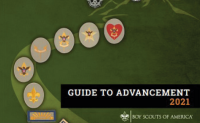 It’s been said that the Boy Scouts of America is responsible for more dead trees than any other organization – based on the sheer number of handbooks, guidebooks, pamphlets, training guides, and other publications.
It’s been said that the Boy Scouts of America is responsible for more dead trees than any other organization – based on the sheer number of handbooks, guidebooks, pamphlets, training guides, and other publications.
Don’t believe me? Just visit your nearest Scout shop. There you’ll find for sale copies of the Scout handbook in multiple formats, a handbook for Scoutmasters, a handbook for the troop committee, the Scout fieldbook, handbooks for various youth leadership positions, over one hundred twenty different merit badge pamphlets, books containing troop meeting planning guides and resource books. There are syllabuses for training Scoutmasters, committee members, and youth leaders, as well as guides for planning Roundtable. Guides for safe Scouting, conducting trips and outings, health and safety … the list goes on. And I haven’t even delved into Cub Scouting.
So why should we add to the clutter by publishing our own handbook?
Most troops I’m acquainted with have a handbook of some sort, and in some format, be it print or online. But when so much is already defined for us, why bother to do our own version of Scouting?
There are risks associated with publishing our own handbook for Scouting in our units. We could inadvertently (or ignorantly) establish bad policy by making up rules for things that run counter to what the BSA has already defined for us. An example would be a provision to turn away from a board of review a Scout who isn’t dressed in full uniform (the Guide to Advancement says we can’t require it), or one limiting the number of merit badges a Scout can take from a given counselor, or one setting a time limit on completing rank requirements.
We could also include citations of BSA policy which, though correct at the time of publication, may end up changing at some point in the future. As we all know, each version of the Guide to Safe Scouting contains changes, as does the Guide to Advancement (big changes last year). The Scout handbooks and rank requirements also change periodically, so unless you constantly conduct editorial review, you may end up publishing bad information.
What, then, is the place of a troop handbook or parents’ guide? The best reason for having one is to provide information unique to your unit. Things like:
- Meeting place, date, time, and exceptions to the schedule
- General campout information – where you leave from and return to, what to bring, driving arrangements, equipment needed, etc.
- High adventure opportunities your troop offers
- Costs – dues, registration, activity fees – and fundraising plans
- The structure of your troop committee and ways that parents can help
- Other information specific to your troop, such as when courts of honor and boards of review are held or how permission slips, medical forms and medications are handled
While most general information about Scouting is well covered in official BSA publications, it’s not convenient, especially for new parents, to go hunting for it or to read all the literature just to find out what they need to know. It can be helpful to expand your handbook to include some of the most commonly sought-after topics, such as
- Advancement
- Uniforming
- The adult role
- Youth leadership positions
- The aims, methods and ideals
- Scouting terminology and abbreviations
and general “how Scouting works” details like differences from Cub Scouts, what the boys do at troop meetings, what the outdoor program is all about, and the patrol method, to name a few.
Sometimes the best way to develop a general concept for a handbook is to think back to when you were new in the troop, and recall what you wished you knew then that you didn’t know and had to learn along the way. By providing as much information up front, you are helping your parents understand why Scouting works the way it does, how it’s different from other youth activities, and make them want to get involved.
Ask around the troops in your area or conduct a Web search to find how other troops do their parent handbooks. Choose a format and style that best fits your troop, and get the word out. It’s essential that we communicate with the troop families about how we do things in order to have a successful troop.
Image: Keattikorn / FreeDigitalPhotos.net
This post first appeared on Bobwhite Blather.



